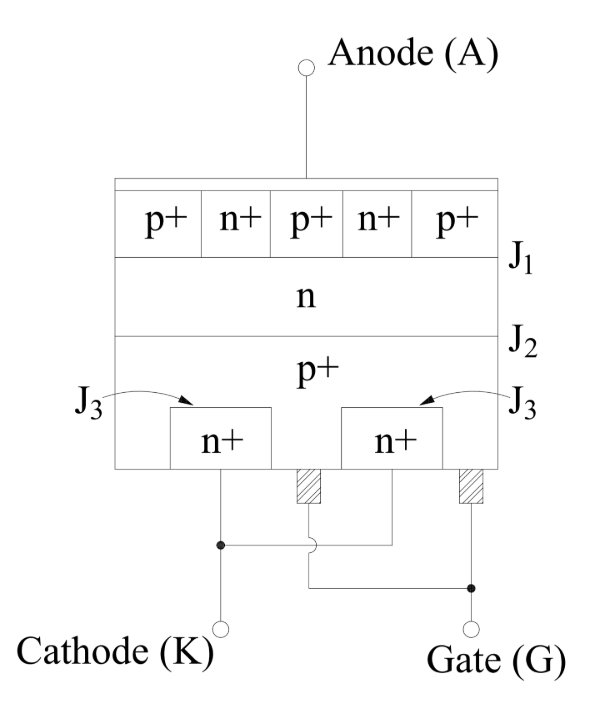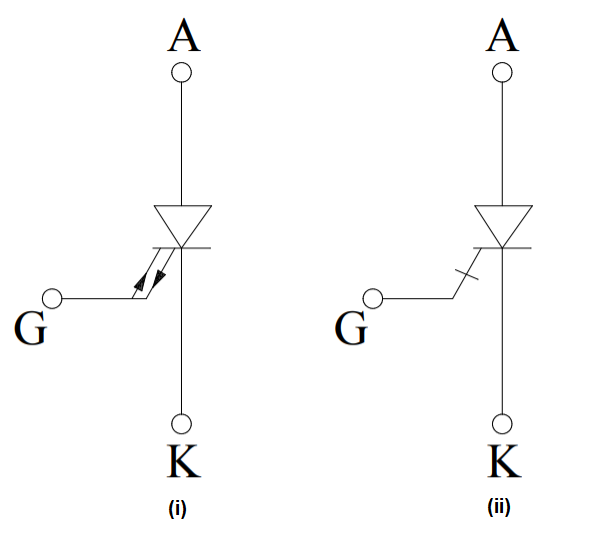What is Gate Turn Off Thyristor (GTO)?
A Gate Turn Off Thyristor (GTO) is a power semiconductor device which can be turned ON and OFF by applying gate current. It is basically a pn pn device which is tuned ON by applying positive gate current and turned off by negative gate current at its gate cathode terminal. In this article, we will discuss about the Gate Turn Off thyristor, its structure, circuit symbol and V-I characteristics.
As we know that, a conventional thyristor (CT) is an ideal switch for power electronic applications. To switch a CT ON, gate signal is applied. But, to turn it OFF, a commutation circuit is required which makes it bulky and costly for various power electronic application. To overcome this problem of conventional thyristor, Gate Turn Off thyristor was developed.
In a GTO, no commutation circuit is required to turn it off. It is switched ON and OFF using the Gate signal only. A positive gate signal is applied to make it ON while a negative gate signal of sufficient amplitude is applied to make it OFF. Thus, it is quite economic and compact. Let us now discuss the structure of Gate Turn Off Thyristor.
Structure of Gate Turn Off Thyristor (GTO):
A Gate Turn Off Thyristor (GTO) is a three terminal pn pn device. The three terminals are Anode (A), Cathode (K) and Gate (G). The basic structure of GTO is shown in figure below.

The four layers are p+ np+ n+ as shown in the above figure. In GTO, the Anode is composed of p+ layer with n+ type fingers diffused in it. Mind that, this is not the case for a conventional thyristor. In conventional thyristor, the anode is composed of only p type.
Symbol of GTO:
The circuit symbol of GTO is shown in figure below.

A GTO may either be represented by symbol (i) or (ii). In symbol (i), two arrows in opposite direction is shown. This is shown to signify the fact that a GTO is a switch which can be totally controlled by Gate signal i.e. it can be made ON or OFF.
V-I Characteristics of Gate Turn off Thyristor (GTO):
The V-I characteristics of a Gate Turn Off thyristor (GTO) is similar to that of a conventional thyristor (CT). Latching current of GTO is, however, several times more than that of latching current of a CT. The latching current is of the order of 2 A whereas the same is around 100 mA to 200 mA for a conventional thyristor. The V-I characteristics of GTO is shown in figure below:

Above V-I characteristics is similar to that of a conventional thyristor. The characteristics consists of four modes / regions: Forward Blocking Mode, Forward Conduction Mode, Reverse Blocking Mode and Reverse Conduction Mode.
In forward blocking mode, only voltage across the GTO is applied without applying the positive gate signal. Hence, it does not conduct in forward blocking mode. However, there is a small forward leakage current which is considerably higher than the forward leakage current of a thyristor. In fact, in forward blocking mode, the GTO behaves like a high voltage low gain transistor which essentially means that the anode current will be low. It should be noted at this point that GTO can only block rated forward voltage if the gate terminal is negatively biased with respect to cathode during forward blocking mode.
The GTO goes into forward conduction mode when it is forward biased and a positive gate signal of appropriate amplitude is applied. When a reverse voltage is applied across a GTO, it blocks the reverse voltage up to a limit but as soon as the reverse voltage reaches a critical value, called the reverse breakover voltage, the GTO starts conducting in reverse direction. This mode of operation does not destroy the device if the gate is negatively biased and the time of this operation is small.
In reverse biased condition of GTO, the blocking capability is dependent on the type of GTO. A symmetric GTO has a high reverse blocking capability while asymmetric GTO has a small reverse blocking capability of the order of 20 V to 30 V.
Hope you liked the post. For any value addition / feedback, please write in comment box.
well define but not explained deeply.
also write the reasons behind…..